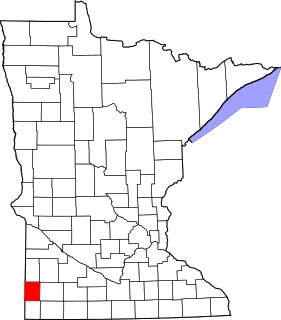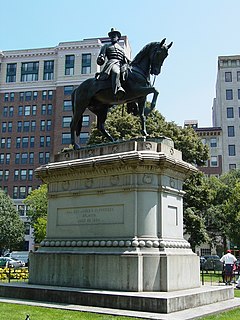
The National Register of Historic Places (NRHP) is the United States federal government's official list of districts, sites, buildings, structures and objects deemed worthy of preservation for their historical significance. A property listed in the National Register, or located within a National Register Historic District, may qualify for tax incentives derived from the total value of expenses incurred in preserving the property.

The Aztec Ruins National Monument in northwestern New Mexico, USA consists of preserved structures constructed by the Pueblo Indians nearly a thousand years ago. The national monument lies on the western bank of the Animas River in Aztec, New Mexico, about 12 miles (19 km) northeast of Farmington. Additional Puebloan structures can be found in Salmon Ruins and Heritage Park, about 9.5 miles (15.3 km) south. Archaeological evidence puts the construction of the ruins in the 12th and 13th centuries. The Puebloan-built ruins were dubbed the "Aztec Ruins" by 19th century American settlers who misattributed their construction to the Aztecs.

Fort Matanzas National Monument was designated a United States National Monument on October 15, 1924. The monument consists of a 1740 Spanish fort called Fort Matanzas, and about 100 acres (0.4 km²) of salt marsh and barrier islands along the Matanzas River on the northern Atlantic coast of Florida. It is operated by the National Park Service in conjunction with the Castillo de San Marcos National Monument in the city of St. Augustine.

George Washington Carver National Monument is a unit of the National Park Service in Newton County, Missouri. The national monument was founded on July 14, 1943, by Franklin Delano Roosevelt, who dedicated $30,000 to the monument. It was the first national monument dedicated to a black American and first to a non-president.

Pipestone National Monument is located in southwestern Minnesota, just north of the city of Pipestone, Minnesota. It is located along the highways of U.S. Route 75, Minnesota State Highway 23 and Minnesota State Highway 30.

Big Hole National Battlefield preserves a Nez Perce War battlefield located in Montana, United States. The Nez Perce fought a delaying action against the 7th Infantry Regiment here on August 9 and 10, 1877, during their failed attempt to escape to Canada. This action, the Battle of the Big Hole, was the largest battle fought between the Nez Perce and U.S. Government forces in the five-month conflict known as the Nez Perce War. In 1992 the park was made a part of Nez Perce National Historical Park, which consists of 38 separate locations in five different states, following the flight of the Nez Perce tribe from the U.S. Cavalry.

Alibates Flint Quarries National Monument is a U.S. national monument in the state of Texas. For thousands of years, people came to the red bluffs above the Canadian River for flint, vital to their existence. Demand for the high-quality, rainbow-hued flint is reflected in the distribution of Alibates flint through the Great Plains and beyond. Indians of the Ice Age Clovis culture used Alibates flint for spear points to hunt the imperial mammoth before the Great Lakes were formed. The flint usually lies just below the surface at ridge level in a layer up to 6 ft thick. The quarry pits were not very large, between 5 and 25 ft wide and 4 to 7 ft deep. Many of these quarries were exploited by the Antelope Creek people of the Panhandle culture between 1200 and 1450 AD. The stone-slabbed, multiroom houses built by the Antelope Creek people have long been of interest to the public and studied by archaeologists. Today, this area is protected by the U.S. National Park Service and can only be viewed by ranger-led guided tours, which must be reserved in advance.

Fort Union Trading Post National Historic Site is a partial reconstruction of the most important fur trading post on the upper Missouri, 1829-1867. The fort site is about two miles from the confluence of the Missouri River and its tributary, the Yellowstone River, on the North Dakota/Montana border, 25 miles from Williston, North Dakota.

Manassas National Battlefield Park is a unit of the National Park Service located in Prince William County, Virginia, north of Manassas that preserves the site of two major American Civil War battles: the First Battle of Bull Run, also called the First Battle of Manassas, and the Second Battle of Bull Run or Second Battle of Manassas. It was also where Confederate General Thomas J. Jackson acquired his nickname "Stonewall". The park was established in 1940 and listed on the National Register of Historic Places on October 15, 1966.

There are more than 1,800 properties and districts listed on the National Register of Historic Places in Florida. They are distributed through 66 of the state's 67 counties. Of these, 42 are National Historic Landmarks.

The San Jacinto Battleground State Historic Site includes the location of the Battle of San Jacinto and the museum ship USS Texas. It is located off the Houston Ship Channel in unincorporated Harris County, Texas near the city of Houston. The site was designated a National Historic Landmark in 1960.

This is a list of the National Register of Historic Places listings in Pipestone County, Minnesota. It is intended to be a complete list of the properties and districts on the National Register of Historic Places in Pipestone County, Minnesota, United States. The locations of National Register properties and districts for which the latitude and longitude coordinates are included below, may be seen in an online map.

Major General James B. McPherson is a public artwork by American artist Louis Rebisso, located at McPherson Square in Washington, D.C., United States. Major General James B. McPherson was originally surveyed as part of the Smithsonian's Save Outdoor Sculpture! survey in 1993. The monument is a bronze equestrian statue of Civil War hero James B. McPherson. The statue is a contributing monument to the Civil War Monuments in Washington, DC, of the National Register of Historic Places.

Tuzigoot National Monument preserves a 2- to 3-story pueblo ruin on the summit of a limestone and sandstone ridge just east of Clarkdale, Arizona, 120 feet above the Verde River floodplain. The Tuzigoot Site is an elongated complex of stone masonry rooms that were built along the spine of a natural outcrop in the Verde Valley. The central rooms stand higher than the others and they appear to have served public functions. The pueblo has 110 rooms. The National Park Service currently administers 58 acres, within an authorized boundary of 834 acres.

Fort Dilts was a makeshift sod fort built near Rhame, North Dakota, United States, in September 1864 to fend off attacks by Hunkpapa Sioux Indians led by Sitting Bull upon an encircled wagon train of would-be gold-miners and a small military escort of convalescent soldiers.

The Stockton Street Historic District covers both sides of Stockton Street, from Railroad Avenue to Summit Street, and a portion of Rogers Avenue in Hightstown, New Jersey. It is notable for its Victorian homes, First Methodist Church, and the Hightstown Civil War monument. It is also significant for its association with the introduction of rail service to New Jersey, as the first railroad in the United States to connect two major cities, New York and Philadelphia, originally ran along what is now Railroad Avenue at the eastern end of the district. In 1832, the John Bull, the first locomotive in the country, provided the first steam-powered passenger rail service in the country, stopping at Stockton Street. In July 2015, Hightstown became a Preserve America community which enhances historic preservation, including the district.


















